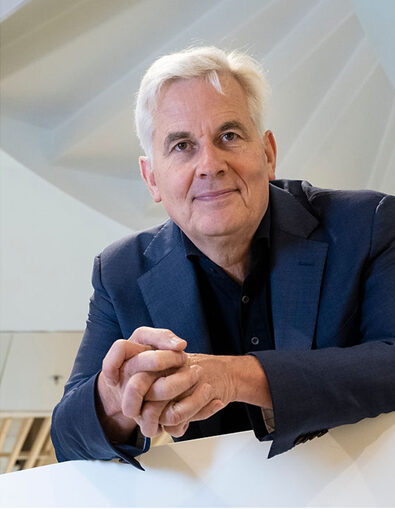 6 min
6 min
Thomas Rau is an architect renowned for his broad contribution to the development of sustainable architecture and for raising awareness of the circular economy. His firm, RAU Architects, is recognized as a pioneer in the production of innovative carbon-neutral, energy-positive and circular buildings. In 2016, he was nominated for the World Economic Forum’s Circular Economy Leadership award. He agreed to share his vision of architecture with us.
Do you think architects need a revolution?
I don’t think we need a revolution. We simply have to organize the reality that will follow the one we know now. In this future reality, we’ll have to completely change our outlook. For example, we will no longer be putting up buildings as we know them today. They will be more the result of a logistical process: a building will be a materials bank, designed so that everything is ready to be reused. Take waste, for example. This is the last vestige of the “old” system, regarded as material without identity, without value. But if you start registering waste using material passports, you give it a new identity, a value. It can then be transformed into new resources for new projects. Let’s treat waste like works of art!
Listen to the podcast: “Bill of Materials” « B… for Bill of Materials »
So it’s less of a revolution and more the need for a profound change in our practices. We really need to keep in mind that, as human beings, we are “guests on Earth”. Nothing belongs to us. Starting from this premise, it will be possible to redesign our economy. Only this change in mindset will bring about a change in our climate trajectory.
As an expert in circularity, do you consider it to be a sustainable practice?
Sustainability has nothing to do with circularity. Sustainability means optimizing the existing system. Circularity means changing it into a new system. So the concept of circularity is quite distinct from sustainability. You can build a sustainable building that isn’t circular and, conversely, design a circular building that isn’t sustainable.
To go further: “Material Matters: Developing Business for a Circular Economy” de Thomas Rau et Sabine Oberhuber (2022, ISBN 9781032193274)
Also to discover on the challenges of circularity:
Do you think we have enough training to speed up the transition?
This is a fundamental question. Today, most people think it’s enough to be clever, to reuse, to minimize, and so on. In my view, we need to broaden our scope and completely change our attitude: it’s about realizing that we are just guests on planet Earth. In no way are we the hosts. The Earth operates in a closed circuit with limited resources, so we have to take care of everything it offers us. You can guess from my answer that, in the face of climate change, what I think we need most is a radical change of mindset. What makes life possible? This is humanity’s grand agenda for the years to come, to realize that we are dependent on everything, and that as guests, we need to change our attitude.
The answer in video form:
The example chosen by Thomas RAU: The building was designed as a materials bank, with all physical components indexed and recorded on the Madaster platform to facilitate reuse in case the building is ever dismantled. Assembled using 165,312 screws, the structure can be fully deconstructed, enabling a 100% circular potential without any loss in the value of materials, components, or products.

1 BaOpt stands for Bauer Optimization and has its origins in Germany. In this air heating system, the air is mixed through a unique diffusion process in which all the incoming air is thoroughly mixed with the air already present. No grids or heavy fans are needed to distribute the air and create a healthy indoor climate. The system ensures that every part of the room receives fresh air and that the temperature is the same everywhere.








